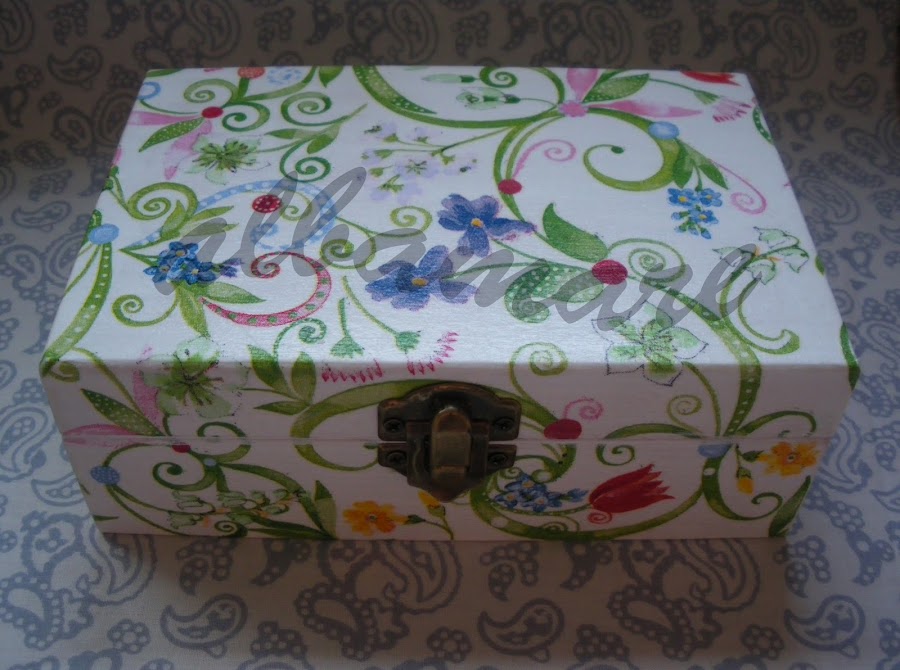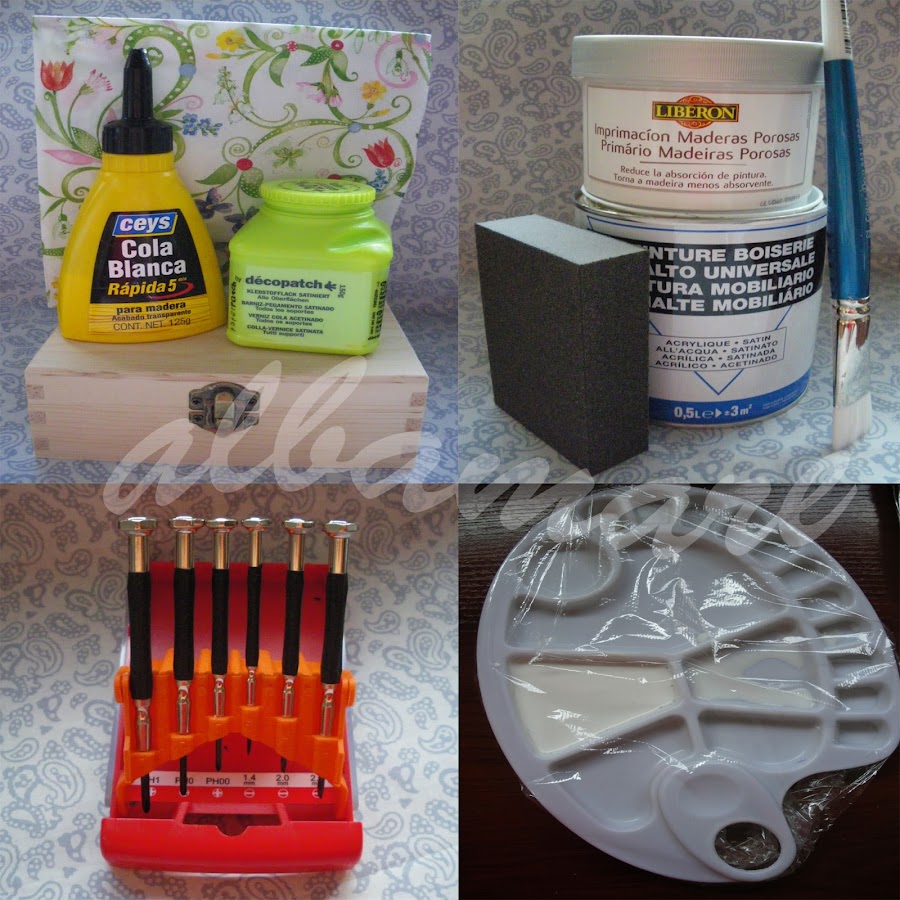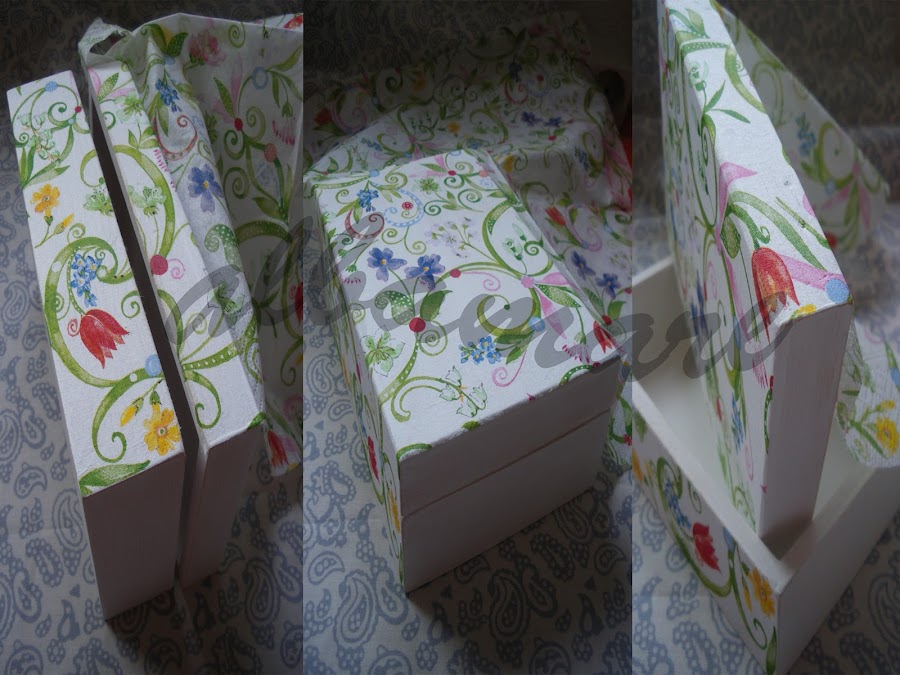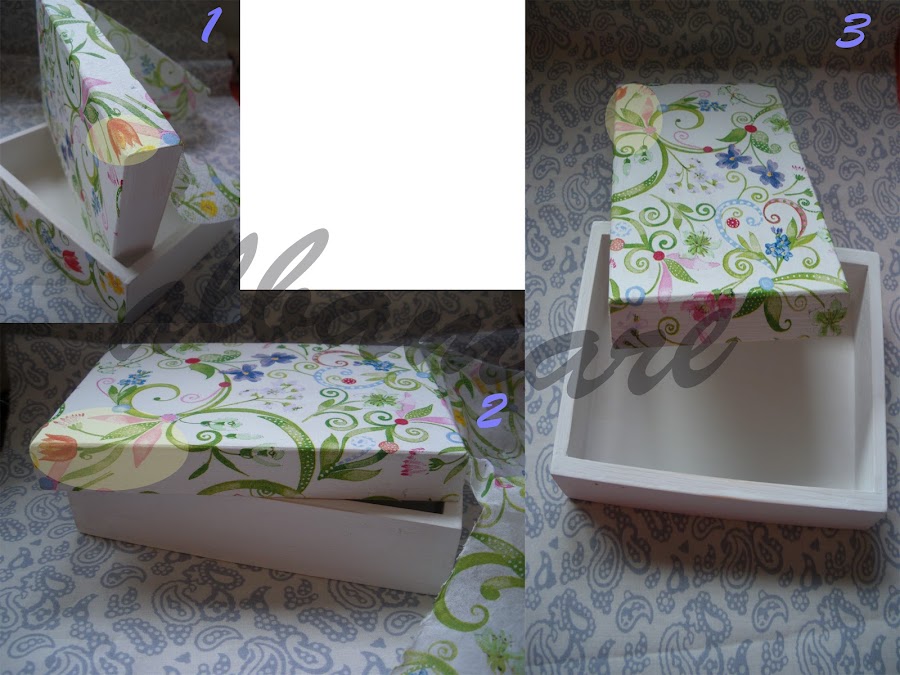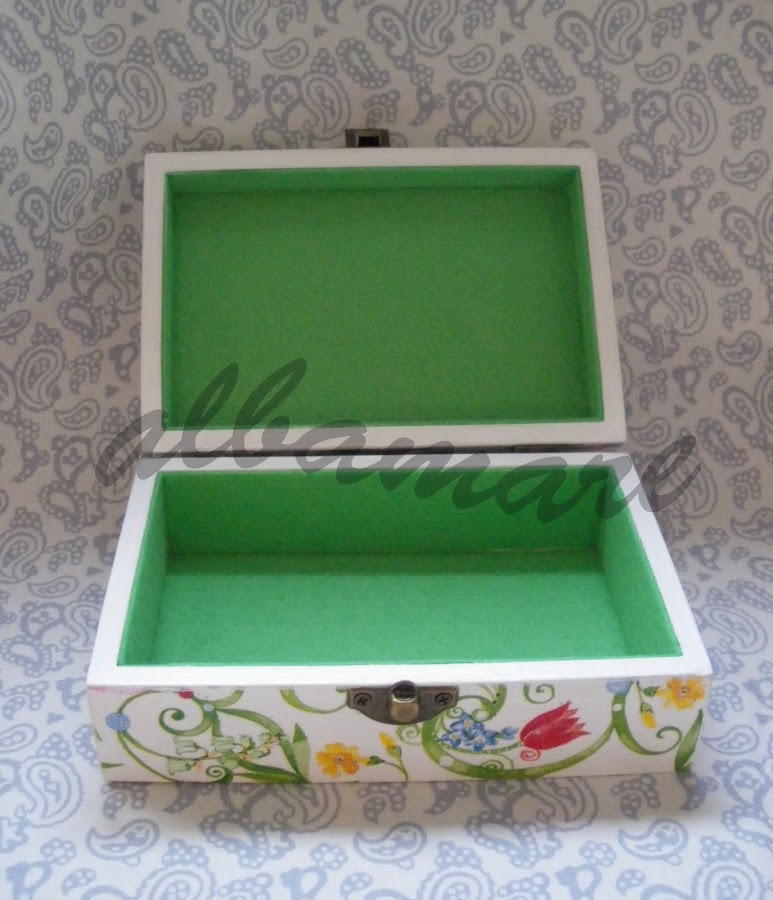Quiero dedicar esta entrada a l@s compis del foro de "manualidades facilisimo.com", que me pidieron que les hiciera un paso a paso. Espero que os guste. Un beso a tod@s!
Me gustaría decir, para empezar, que desde mi humilde experiencia y en mi opinión, todas las manualidades siguen tres pasos básicos:
1.- Acondicionar nuestro soporte, si fuera necesario.
2.- Desarrollo de la manualidad en sí.
3.- Acabado "protector".
Así, por ejemplo, en la costura, el primer paso sería cortar la tela según nuestros patrones; el segundo paso sería montar la pieza y realizar ajustes si fuera necesario; y, el tercer paso sería sobrehilar y/o rematar.
Lo que quiero decir con esto es que considero que los procedimientos de las manualidades son los mismos, están abiertos y son susceptibles de cambios y mejoras; y añadir que, por supuesto, el resultado también depende de los materiales que utilicemos.
Y, tras esta introducción, os muestro la caja que vamos a realizar:
Hello everybody!
I want to dedicate this entry to my partners from "manualidades facilisimo.com" forum, who asked me this tutorial. I hope they like it. Kisses for everyone!
To start with, I would like to say, from my point of view and modest opinion, all handicrafts follow three basic steps:
1.- Preparing our hardware, if it is necessary.
2.- Developing the handicraft.
3.- Protecting it.
So, for example, when you saw, the first step would be cutting the pattern on the fabric; the second step would be to assemble the piece and fit if it"s necessary; and, the third step would be to finish it.
I mean I think all handicrafts processes are equal, open and can be changed and improved; of course, the result depends on the materials we use.
And, after this introduction, I show you the box we are going to decorate:
Caja de madera adornada con la técnica de decoupage
Wood box decorated with decoupage technique
Los MATERIALES que he utilizado son:
a) Caja de madera.
b) Destornilladores de precisión.
c) Lija de grano fino para madera.
d) Paletinas.
e) Tapaporos a modo de imprimación.
f) Pinturas acrílicas.
g) Cola blanca de acabado transparente y un recipiente donde rebajarla con agua.
h) Servilleta decorada.
i) Una bolsa de plástico transparente y un trapo.
j) Barniz satinado.
I have used these MATERIALS:
a) A wood box.
b) Precision screwdrivers.
c) Soft sand paper for wood.
d) Flat paintbrushes.
e) Primer prior to paint.
f) Acrylic paintings.
g) White glue with transparent-finished and a container where you can mix it with water.
h) A decorated napkin.
i) A transparent plastic bag and a cloth.
j) Satin-finish vernish.
Materiales y herramientas
Materials and tools
Primer paso: Acondicionar nuestro soporte, si fuera necesario.
First step: Preparing our hardware, if it is necessary.
Para empezar, desmonto el cierre y las bisagras de la caja con un destornillador de precisión, para poder trabajar más cómoda.
A continuación, lijamos bien la madera y retiramos el polvillo con un trapo.
To start with, I unscrew the lock and the hinges, in order to work more comfortable.
Next we sand the wood box down and dust the box with a cloth.
Seguidamente, aplicamos una generosa capa de imprimación y dejamos secar.
After, we prime the wood generously prior to painting and allow it to dry.
Segundo paso: Desarrollo de la manualidad en sí.
Second step: Developing the handicraft.
Ahora, pintaremos la caja según el color que queramos para el fondo de la servilleta y elegiremos otro color o el mismo para las partes que no estarán cubiertas por la misma. Yo he escogido el color blanco para toda la caja.
Rebajamos la cola en un recipiente que podamos cerrar, para reservar nuestro adhesivo en los tiempos de espera. Yo utilizo una paleta de mezcla de pinturas y la tapo con un film transparente, pero podéis utilizar cualquier bote que tengáis en casa.
Separamos las tres capas de la servilleta y nos quedamos con la primera capa.
Now, we will paint the box according to the colour we want under the napkin and will choose other colours to paint the rest of the box. I have just chosen white.
We mix the glue with some water in a container which we could close, to keep our adhesive any waiting time. I use a palette and cover it in film, but you can use any container you have at home.
We separate the three sheets of the napkin and keep the first one.
Separamos las tres capas de papel de la servilleta
We separate the three sheets of the napkin
Como se puede ver en la fotografía de abajo, aplicamos una fina capa del adhesivo que hemos preparado en la base frontal de la caja y colocamos la servilleta.
Ayudándonos de un bolsa de plástico transparente y un trapo, presionamos desde el centro hacia los extremos.
Y, para cortar la servilleta nos ayudamos de la lija.
As you can see in the picture below, we apply a thin adhesive coat on the box front base and put the napkin on.
We put the transparent plastic bag on the napkin and press the cloth down from the middle to the extremes.
In order to cut the napkin we use the sandpaper.
Si miras la siguiente fotografía, sigo pegando la servilleta sobre la tapa por su parte frontal, a continuación de donde hemos cortado anteriormente siguiendo el dibujo.
Pegamos la parte de arriba y seguimos pegando la parte trasera de la tapa.
If you see the next picture, I continue sticking the napkin on the top front, so that we will see the floral pattern continued.
After that we stick the top and the top back.
Cortamos la servilleta por la parte trasera y la parte delantera.
Partiendo de la última imagen anterior (foto 1) de referencia, la parte trasera de la tapa queda como se ve en la foto 2 y el lateral izquierdo de la tapa se ve en la foto 3.
We cut the napkin we have on the back.
If you keep the last image (picture 1), the top back will be the picture 2 and the left side is seen in the picture 3.
Para terminar, ya sólo nos queda el lateral izquierdo y trasero de la base de la caja.
Siguiendo el dibujo de la servilleta quedan como sigue:
Afterward we just stick the left side and back of the box base.
If we follow the napkin floral pattern, the left and back side will be like this:
En el lateral derecho no he pegado servilleta porque he preferido pintar ese lateral.
I haven"t sticked napkin on the right side because I have prefered to paint that side.
Tercer paso: Acabado "protector".
Third step: Protecting it.
Y para terminar le damos dos manos del barniz que hayamos escogido (brillo, satinado o mate).
Otra opción para terminar el interior de la caja sería forrarlo con terciopelo adhesivo de un color que le vaya a la servilleta escogida. Yo, en este caso, he forrado la caja con fieltro porque no hay este color y el efecto protector es prácticamente el mismo. Esta sorpresa es para los que hayáis llegado hasta aquí leyendo, jajaja!
To protect it we varnish twice. We can choose glossy, satin or matte finished.
Other option to finish the interior part would be to wrap with adhesive velvet in a colour to match your choosen napkin. In this case I have wrapped inside the box with felt because they didn"t have this colour and the protective effect is the same. You will have this surprise if you are still reading, hahaha!
Interior forrado con fieltro. Nuestra caja ahora es un joyero!
Felt inside. Now our box is a jewelry box!
Y, este es el resultado final, la caja desde todos sus ángulos:
And, this is the final result, the box in all its angles.
Resultado final
Final result
Qué os ha parecido?
What do you think?


